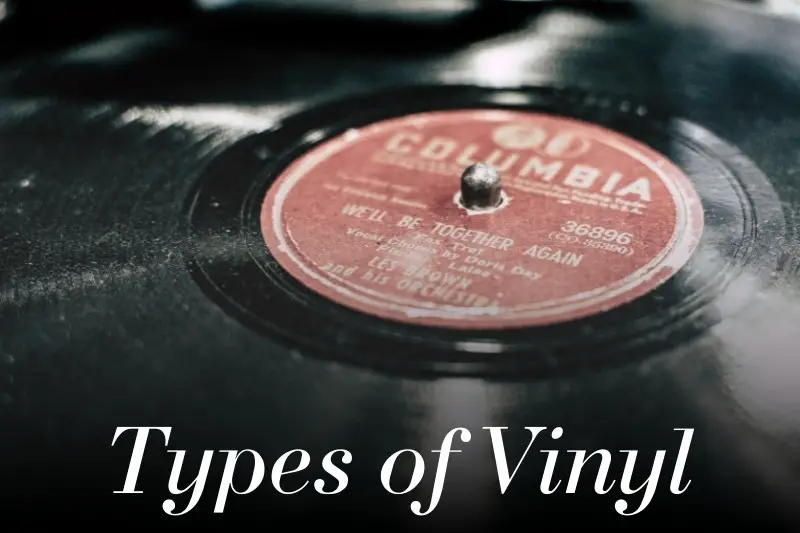Vinyl records have enjoyed a long and healthy life up to now. During the heyday of vinyl records, an album was often something closer to a novel. An artist might release a set of songs in a particular order to tell a specific story. But, there were also vinyl singles, and there were different sizes and speeds as well. So, let’s take a look at the different types of vinyl records that you might come across.
Vinyl records can vary widely. Sizes range from 7-inch singles and 10-inch records up to 12-inch albums. Also, differences in playback speed range between 33 and 45rpm, up to 78rpm records. You may find some unusual shapes and colors too. You should choose a record type to match your record player.
Let’s talk about the various sizes of vinyl records
Vinyl record size is often misunderstood in relation to the amount of information that can be stored, how long the record will play, and much more. What’s important to remember is that the size of the record is not the primary factor in determining how much music you’re going to get. Some larger records offer a shorter playback time simply because they spin so much faster. But, we’ll get to that next.
Some of the articles on our site contain affiliate links. We're careful about what we review and recommend. As an Amazon Associate, we may earn something small from qualifying purchases. Thanks for the support!
Let’s talk about record size.
7-inch records
This is one of the more common types of vinyl records. They’ve been around since the 1940s. You may come across 7-inch singles when going through an older relative’s collection if they were music lovers in the 50s and 60s.
Often, 7-inch records require an adapter to fit on standard record players. You won’t need a special stylus, or needle, to play them, but you will probably need a record insert or spindle adapter.
10-inch records
This size record is usually an older, shellac-based record that is meant to be played at 78 RPM. They’re usually thicker and heavier than modern 12-inch albums, and they have been around since the late 1800s!
12-inch vinyl records
This is your standard full-length Long Playing album that has been around for decades and still shows up today with new releases. They are very popular because they can hold roughly 45 minutes of music on them, and they have become the standard in album-length releases.
You can find everything from symphony orchestras and cello recitals to punk rock and The Postal Service on this type of record.
12-inch singles
Note that there are 12-inch singles out there, and they were quite popular for a while. They’re the same size as full-length LP albums, but they only featured one or two songs on each side.
They’re still meant to be played at 45 RPM just like a 7-inch single, but because they’re larger you could fit a couple of extra songs on them which helped make them popular for a time.
Vinyl RPM speed explained
It seems like there are quite a few different vinyl record speeds out there in the wild. But, really there are only three main RPM speeds to remember. When we say RPM of the record, we mean revolutions per minute. Basically, it refers to the number of times a record will spin each minute. The higher RPM records will go around more times each minute than lower RPM records.
To be clear, you may actually find five different RPM speeds for vinyl records. However, 16 2/3 and 80 RPM are quite rare. Just know that they do exist.
One other thing to keep in mind is that the size of the record doesn’t necessarily determine the RPM speed. Some albums that are larger in size actually spin at faster speeds than some of the smaller single vinyl records.
33 1/3 RPM records
33 1/3RPM is one of the most common record speeds you’ll find. Standard, 12-inch LPs fall into this category. And, if you buy a new standard size album it will almost always be 33 1/3 RPM.
This is the slowest common speed that you’ll find, and it makes it possible to fit many tracks on a full-length album. You’ll find all genres on these types of records, from classical music to rock, funk, metal, and indie pop. A single disc of this size and speed can hold somewhere around 15 to 20 minutes of music.
45 RPM records
45 RPM records are almost always smaller, 7-inch singles that hold one song or track on each side. An interesting note is that when a band would release a single, they would usually put out a song that they thought was going to be a hit, and this was called the “A” side. The “B” side was a song that they figured might not get as much airplay, so it wouldn’t interfere with the main single’s release. Over time, people loved to collect those lesser-known, but often incredible, songs that came to be known as “B sides”.
The term “single” is almost synonymous at this point with 7-inch 45 RPM records.
78 RPM records
78 RPM records are, to me, one of the most fascinating types of vinyl records out there. It might just be nostalgia, but I love them. These old records are thicker records that you might find in your grandparent’s attic or garage. At least, that’s where I found them decades ago. They’re actually shellac records (bug secretions!) that need special needles to be played. Shellac records have a different feel from vinyl, and they make a great addition to a record collection.
78s are heavy, thick, and carry something old and unique about them. You can find some incredible older artists on these types of records, as long as you have the right type of stylus and record player. They aren’t so rare that you’ll never come across them, but they’re ubiquitous either like a 7-inch single. They have a very distinct sound quality to them as well. I recommend trying them out if you’re getting serious about record collecting.
“Other” types of vinyl records
Colored records
The first time I came across a colored record was the Elvis Presley album Moody Blue. As a kid, it blew me away. I thought it must be something incredibly valuable and rare. Well, turns out that while some pressings are worth quite a bit today, it’s not nearly as rare as I thought back then. It’s still a really cool-looking record.
Colored records aren’t really all that rare. They’re very striking and fun to collect, but making them is just a matter of using colored pellets during the pressing of the record.
If you can find a band you really like and they’ve released a colored version of an album you like, definitely pick one up.
Picture discs
Records with pictures on them are also somewhat common, although a bit less so than normal colored records.
Also, one drawback with picture discs is that due to the way they’re made, the sound quality can suffer. If you’re simply picking it up to add to a collection, go for it. However, if you’re looking for something to play in heavy rotation on your record player, you may want to find a standard, non-picture option if there is one.
Special shapes and materials
Records that feature odd shapes and materials definitely fall into that “specialty” or novelty type of category. There are shapes ranging from states of the US, people’s faces, and on and on.
There are also records that have been pressed with many strange types of materials from chocolate to wood records that have been cut with lasers. If you’re a collector, you can find just about anything to put into a record collection.
FAQs
Can you get new music on vinyl records?
Yes, you can. In fact, Adele and Taylor Swift crushed vinyl sales in 2021. Many new bands release new material on vinyl each year. You can find these new releases in shops everywhere from your local music store to Walmart and Target.
Is vinyl still popular?
Yep.
According to Billboard, vinyl sales comprised 38.3% of all album sales in 2021. This includes physical and digital sales combined! So, yeah we’d say vinyl is still pretty darn popular. In fact, it’s getting more and more popular each year lately.
Types of vinyl records: Final thoughts
Whether you’re a vinyl enthusiast or just a lover of good music, even a small record collection can be a wonderful way to enjoy your favorite artists. New vinyl records are being released all the time by record companies big and small. As we’ve mentioned, the sound quality of well-cared-for, higher-quality 12-inch records is something difficult to recreate in other formats.
Whether you believe in the “vinyl is warmer” claim, the experience of throwing a record on your Crosley, your Victrola, or your high-end system can’t be beat. We love streaming around here for sure, but the tactile experience and vibe of handling different types of records is something special. Lowering that needle and hearing that little bit of crackle as the song starts can create a mood that no CD or streaming device can.
So, as that record spins, sit back, relax, and enjoy an entire album the way the artist meant it to be heard.




